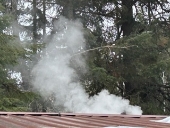


Peter van den Berg wrote:Let me guess a few things. The ceiling is mortared in, so there's a rigid connection between bell walls and ceiling. This is asking for trouble, this connection should be done with flexible material, a strip of superwool or braided glass rope for example. The ceiling tends to expand a lot more than the walls so the mortar between those run a fair chance to crack badly.
Peter van den Berg wrote:The same goes for the connection between the firebox/cooking plate and the bell, or tower, whatever term you prefer. The hotter steel of the cooking plate will expand a lot more than the bricks of the bell so this connection should be flexible as well. Even the bricks of the firebox' sides could be getting hotter than those of the bell, causing similar problems. Replacing those connections by a glass rope should solve most if not all of this.
Peter van den Berg wrote:
teri andersen wrote:2. We put in the temp gauge which he tells me reads between 150 & 175 regularly.
I'm assuming this is in Fahrenheit. The 150 ºF is too low when read while the heater is at full bore. Condensation temperature is something between 100 and 130 ºF, so your lowest reading is dangerously close. Running at full bore, this temperature reading should be 200 ºF since at the top of the chimney it will be lower than that. Maybe, just maybe, the chimney is too cramped...
Peter van den Berg wrote:The proper way to connect stove pipes is with the crimps down, so water will stay inside the heater. But... the first pipe isn't properly done, the second one connects over instead of in the first one with black and stinky smudges on the well-done masonry as the result. The clean-out hatch is a similar case, the hatch is much colder than the brick around it so inside the hatch the vapor will condense and drips out. Filling that hatch with rockwool usually solves this.
Peter van den Berg wrote:Provided there aren't any other higher roofs nearby this should be sufficient although the chimney as a whole could be longer. In my home country standard minimum length of a chimney should be around 16', just to give an idea.

Mike Haasl wrote:
Peter van den Berg wrote:
teri andersen wrote:2. We put in the temp gauge which he tells me reads between 150 & 175 regularly.
I'm assuming this is in Fahrenheit. The 150 ºF is too low when read while the heater is at full bore. Condensation temperature is something between 100 and 130 ºF, so your lowest reading is dangerously close. Running at full bore, this temperature reading should be 200 ºF since at the top of the chimney it will be lower than that. Maybe, just maybe, the chimney is too cramped...
Just to check, Teri, is that a surface mount thermometer? It looks like it. So it's measuring the temperature of the metal pipe. Peter, I think you wanted to know the temperature in the middle of the pipe? Maybe you saw Teri's thermometer and adjusted your temperature suggestions accordingly and my post isn't needed. But I figured I'd mention it in case there's a misunderstanding regarding how the temp is measured.


Glenn Herbert wrote:Concerning the odor issues, US building code for masonry heaters mandates a double shell for precisely the point of controlling tiny leaks in the inner shell. If a hairline crack develops that could allow some partially combusted gases to escape, the outer shell will keep almost all of that from being able to escape into the room.

Glenn Herbert wrote:If the chimney top is only 2' above the roof at its exit, I think you will benefit from raising it. Common US building code is for the top of a chimney to be at least 2' higher than any roof within 10', and 3' higher than the roof at its exit point.





